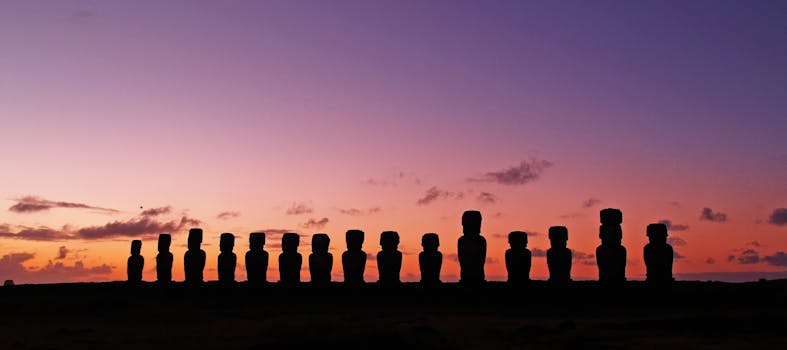Discover the Mysterious Easter Island
Located in the southeastern Pacific Ocean, Easter Island, or Rapa Nui, is one of the most remote inhabited islands in the world. Famous for its iconic moai statues, this UNESCO World Heritage site is a treasure trove of history, culture, and mystery. With a population of around 7,750 people, the island is not just a destination for tourists but also a subject of fascination for archaeologists and historians alike.
The Enigmatic Moai Statues
The moai statues are perhaps the most recognizable feature of Easter Island. These monolithic figures, carved from volcanic tuff, are believed to represent the ancestors of the Rapa Nui people. Standing at an average height of 13 feet and weighing up to 14 tons, the moai are a testament to the ingenuity and craftsmanship of the island’s early inhabitants.
History and Significance
The construction of the moai began around 1400 AD and continued until the late 19th century. Each statue was erected on a stone platform called an ahu, which served as a tomb for the individual it represented. The moai were not merely decorative; they played a crucial role in the Rapa Nui culture, symbolizing power and authority.
- Spiritual Significance: The moai were believed to embody the spirits of ancestors, providing protection and prosperity to the community.
- Social Hierarchy: The size and number of moai built by a clan indicated their social status and wealth.
- Engineering Marvel: The transportation of these massive statues across the island remains a subject of research and debate, showcasing the advanced engineering skills of the Rapa Nui people.
The Mystery of Their Decline
Despite their impressive achievements, the Rapa Nui civilization faced significant challenges that led to its decline. Deforestation, overpopulation, and the introduction of European diseases in the 19th century contributed to a dramatic decrease in the population and the eventual abandonment of many moai.
Environmental Impact
Studies suggest that the extensive deforestation caused by the Rapa Nui people to create farmland and transport moai led to soil erosion and a decline in agricultural productivity. This environmental degradation is often cited as a critical factor in the societal collapse.
Visiting Easter Island: A Unique Experience
For travelers, Easter Island offers a unique blend of natural beauty, rich culture, and historical intrigue. The island is home to stunning landscapes, including volcanic craters, pristine beaches, and lush greenery. Here are some must-visit sites:
- Rano Raraku: The quarry where most moai were carved, featuring hundreds of unfinished statues.
- Ahu Tongariki: The largest ahu on the island, restored to display 15 moai facing the sunrise.
- Orongo: A ceremonial village located on the edge of a volcanic crater, known for its birdman cult.
Practical Information for Travelers
When planning a trip to Easter Island, consider the following:
- Best Time to Visit: The island enjoys a mild climate year-round, but the best time to visit is during the Southern Hemisphere summer (December to February).
- Getting There: The island is accessible via flights from Santiago, Chile, with a flight time of approximately 5 hours.
- Accommodation: Options range from luxury hotels to budget hostels, catering to various preferences and budgets.
Conclusion: A Journey into the Unknown
Easter Island is more than just a destination; it is a journey into the unknown, filled with enigmas and lessons from the past. The moai statues stand as silent witnesses to a civilization that thrived and then faced adversity. As we explore this unique island, we are reminded of the delicate balance between human achievement and environmental sustainability. Whether you are an adventurer, a history buff, or simply seeking a unique travel experience, Easter Island promises to leave an indelible mark on your heart and mind.
